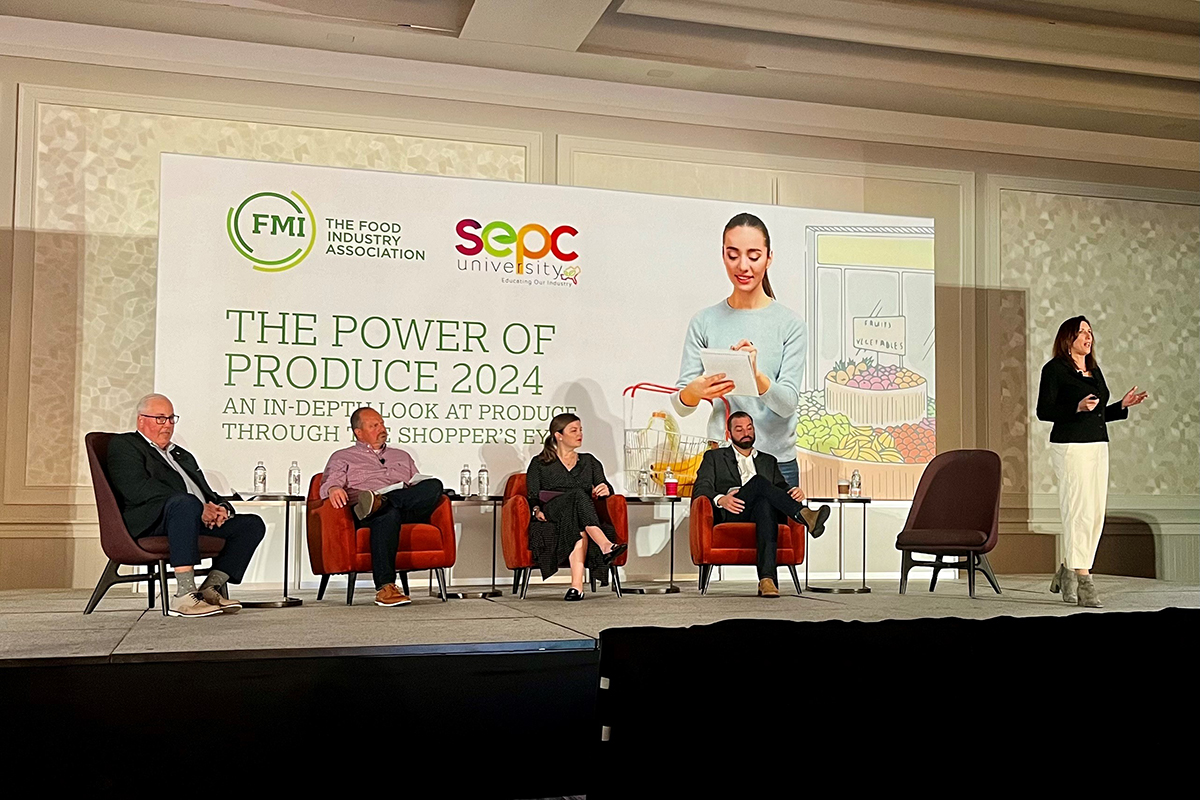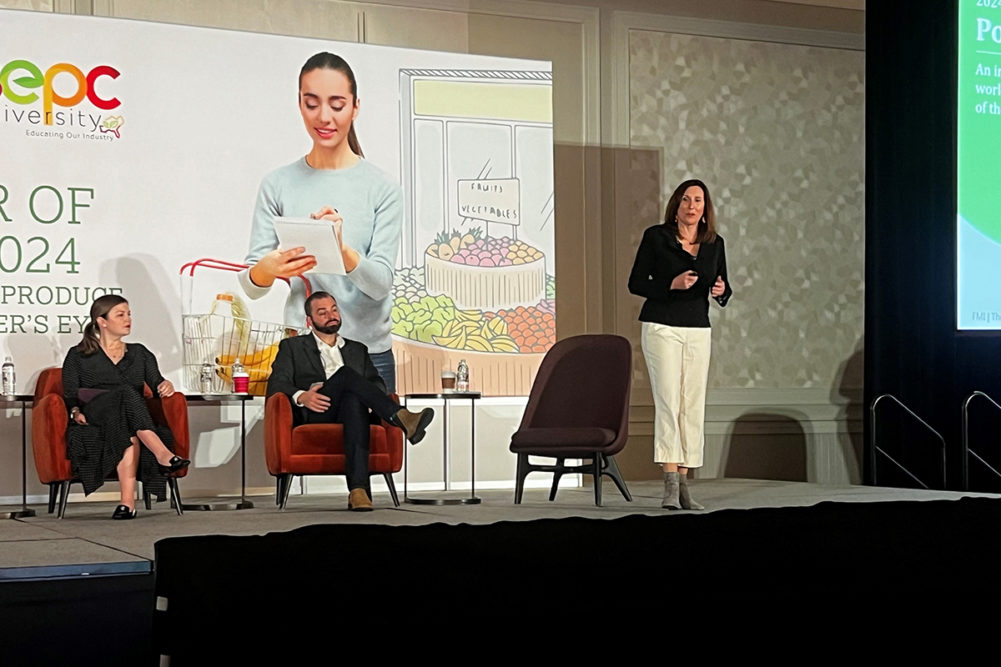TAMPA, FLA. — Impulse purchases, displays and in-stock value were three of the main themes during the FMI – Food Industry Association’s ‘Power of Produce 2024’ session at the Southeast Produce Council (SEPC)’s Southern Exposure March 8.
Anne-Marie Roerink, president at 210 Analytics, presented the report alongside Rick Stein, vice president of fresh foods at FMI.

From left to right: Rick Stein, Jon Greco, Melissa Thrasher, John Clear, and Anne-Marie Roerink.
| Source: Hayley Hyer / Sosland Publishing Co.Stein moderated a panel of produce industry leaders including Jon Greco, senior director of produce sourcing at Sysco Corporation; Melissa Thrasher, procurement team leader at Whole Foods Market; and John Clear, senior director at A&M Consumer and Retail Group.
“Adding panelist insights from our Unseen Heroes to the Power of Produce data helps bring the study findings to life," said Mike Roberts, SEPC Chairman. “Session panelists provided valuable context to this information highlighting how they use cross-merchandising, eye-catching displays or seasonal items to drive impulse. This highlights the crucial role of those working behind the scenes to bring fresh produce to our tables."
Inflation, pricing and value in produce
Speaking to the current economic condition in the United States, Roerink shared that 3 out of 10 consumers surveyed said prices across all grocery store departments are “stupid expensive.”
However, Roerink said the produce department has fared better than others, remaining steady over the last few years.
“If we look at inflation, we see in fresh produce, we are far below average,” Roerink said. “The fresh produce department has actually done a tremendous job compared to other departments in the store. While steady is perhaps not the outcome we are looking for, the current environment is quite an accomplishment for fresh produce.”
Roerink attributed some of the success the produce department has had to demand.
“What’s very unique about produce is, look at the household penetration,” Roerink said. “Everybody buys produce.”
While produce in general is still high in demand, Roerink and the panel put a heavy emphasis on the importance of creating value to drive more sales.
“Pricing is extremely important,” Clear said. “It’s not just the cost someone is paying; it’s the value people are getting. People are willing to spend more on produce, but they are a lot more discerning on what they are getting for that cost.”
Clear said consumers are likely to switch the retail store they buy produce from if they are not satisfied with the value.
“You have one chance to give the value for what someone wants to pay, and if they don’t get the value, they’ll go somewhere else going forward,” Clear said.
Throughout the session, the other panelists agreed that just one disappointing shopping experience can cause a consumer to look elsewhere.
When discussing promotions for the produce department, Roerink pointed out the importance of keeping the advertised products in-stock to retain consumer loyalty, as 54% of purchases resulting from out-of-stock items or poor displays lead customers to go to a different store, forgo the purchase entirely, or opt for the frozen/canned version.
“If they are planning to buy something and need certain items, there is no better way to tick off somebody and ruin their day by having out-of-stocks, especially on something that was on sale,” Roerink said.
Clear suggested increased communication throughout the supply chain can help prevent surprise out-of-stock situations in retail.
“Partner with growers and ask about what’s growing well for you,” Clear said. “You don’t always know what’s really happening on the ground, in the fields. Don’t assume something is always available at the same levels year-round.”
Thrasher agreed and said when planning promotions, to plan with the growers and ask what kind of season they are going to have.
Roerink suggested retailers try offering shorter three-day, or even one-day, promotions for items they know are low in supply.
Another benefit of communicating more with farmers and growers is being able to have more transparency with consumers.
“People want to know more about where their food comes from, who grew it,” Roerink said. “They don’t want to spend hours on their phone trying to figure it out; they look to the retailer to provide the information.”
Roerink recommended instore signage showing “farms we trust” and providing information about locally grown products on the packaging, as well as online.
Thrasher said Whole Foods consumers tend to start their shopping in the locally grown section.
“In our own market research, we found customers look at local first, then move into other departments in the store,” Thrasher said.
Clear added that featuring growers and farmers, without advertising one specific product, can boost the entire fresh produce department.
“We’ve been doing partnerships with growers to get in the field, take photos and videos,” Clear said. “Sometimes people want to tie an initiative to a direct sale, but sometimes the effort is about the impact on the whole department.”
Roerink also said more consumer education on the health benefits of produce items, such as vitamin C boosting immunity, can increase sales.
“Produce has an overall health halo, always has always will,” Roerink said. “But we have an opportunity to zero in on those health benefits — not just the features, but the benefits. Why are these things important for nutrition?”
Roerink also said education on produce storage and usage will build customer loyalty.
“The way the world is moving is a focus on food waste,” Roerink said. “Consumers are saying, ‘I simply cannot afford to waste food in the current economic environment.’ Give tips like putting a paper towel in with spinach to keep fresh longer. What goes in the fridge, what not to put in the fridge? Those are the kind of things we need to communicate to the consumer. Tell them if something is going bad but still tastes great in the smoothie.”
Impulse purchases in produce
The ‘Power of Produce’ report found 89% of consumers make unplanned produce purchases.
This is largely due to the visual appeal of produce in-store. An interesting point Roerink and the panelists made was not to take away from the natural power of produce with too much going on.
“The last thing we need to do is undermine the visual appeal of produce with too much signage,” Roerink said.
Regarding cross-merchandising, which Stein said we know works but has operational challenges, Thrasher said shoppers still need to be able to find the products they are looking for in their usual places.
“You don’t want to interfere with customers' shopping,” Thrasher said.
Seasonality is another reason for unplanned produce purchases. Clear said when people make their shopping lists, they might just write “berries” but then go to the store to see which berries are in season and have the best appearance and value.
Roerink said consumers are more likely to buy a higher-priced produce item during holiday seasons.
“People say, ‘I’m going to splurge a little more because this is a special occasion,’” Roerink said. “During holidays when people are willing to splurge, you see value-added doing well. In-between seasons, people are more willing to get the knife out and take the time to slice.”
Roerink said value goes beyond the price, and it is important for retailers to consider all factors to stand out from the competition.
“What are the traits of a great produce department? Appearance, prices clearly marked, no surprises when you checkout, variety, shopper education,” Roerink said.

